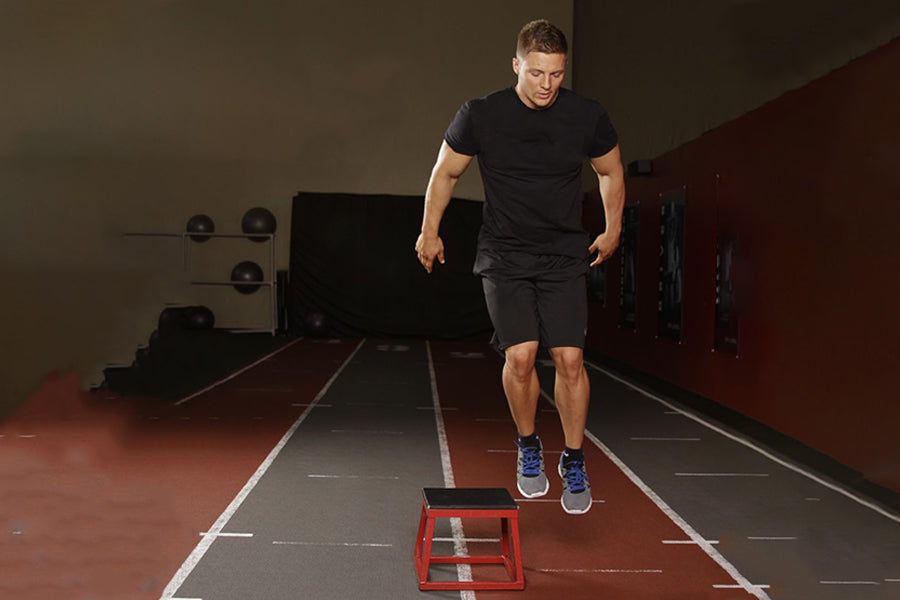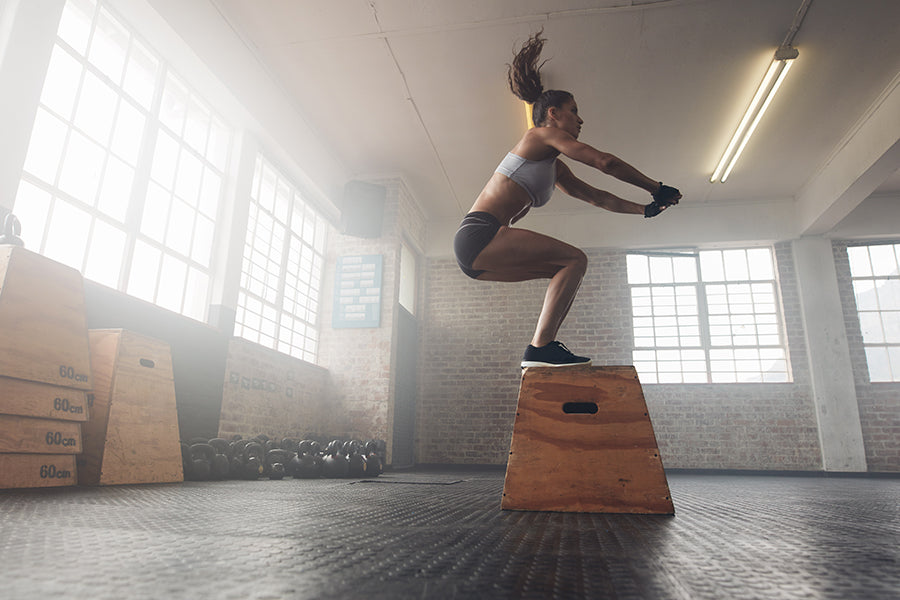Box jumps are a great option to consider when it's time to pump up your strength training routine. But, like many exercises, there's a lot of misinformation about how to do them correctly. So, we're here to clear the air and ensure you make the most of this explosive exercise.
Box Jumps is a challenging exercise that requires a lot of strength and power to complete successfully. And if you're just starting with this exercise, you may wonder how to do it right.
In this post, we will look at how to do box jumps, a challenging workout for anyone who wants to build explosive strength and improve their overall fitness levels. We will show you the steps involved in performing this exercise and give you tips and tricks to get the most out of it.
What is a Box Jump?
A Box Jumps involves jumping from the ground onto a box or elevated object, such as stacked weight plates. Box Jumps can be performed in several variations, each targeting a different area of the body and adding a new challenge to your workout routine. These include Depth Jumps , Single Leg Box Jumps, and Lateral Box Jumps. But first, let's glance at the basics of this exercise.
Related Article: Box Jumps Exercise Guide
How to Do Box Jumps?
Setting up for the Box Jumps is simple. All you'll need to do is measure out a box that is the right height.
- Set up the box in front of you. Your box should be low enough so that you can comfortably jump onto it with both feet simultaneously.
- Bend your knees into a squat position and with explosiveness jump, shuttling your force upwards.
- As you jump, extend your arms and legs.
- As you reach the height of the box bend your knees to land softly on the balls of your feet followed by your heels.
- Stand up right and either step down or jump down to complete the movement.
Note- Each rep should be performed as explosively as possible to maximize the intensity and benefit your calves and glutes. Aim for 10-12 reps using a full range of motion.
What Muscles Do Box Jumps Work?
Box jumps primarily target the quads, hamstrings, glutes, calf muscles, and abdominals. However, as you perform these exercises, they also engage many other smaller muscle groups throughout the body.
Performing box jumps regularly is an amazing way to improve your overall strength, flexibility, and agility. These exercises will also help improve cardiovascular health and tone and strengthen your core muscles. Plus, because they require minimal equipment, they're a great workout at home!
Here's a breakdown of all the muscles worked when performing this exercise:
Quads
The Quadriceps consist of four muscles in the front of your thigh: the rectus femoris, vastus lateralis, vastus medialis, and vastus intermedius. All of these muscles work together to extend the hip and knee.
When performing box jumps, you must extend your knees with force against gravity to jump onto the box or down from it. This exercise works all four primary Quadriceps areas and promotes good form and symmetry in the muscle group.
Hamstrings
The Hamstrings are three muscles in the back of the thigh. They are the biceps femoris, semitendinosus, and semimembranosus. All three of these muscles work to extend the hip as well as stabilize the knee joint. As you can see, their function is similar to that of the Quadriceps.
The main difference is their position behind the thigh rather than in front of it. With Box Jumps, you'll contract your hamstrings as you bend your knees as you land from a jump (or as you're about to jump) and then quickly extend them again to propel yourself into the air again.
Glutes
The Glutes are a group of 3-4 muscles at the bottom of your pelvis. They include the Gluteus Maximus, medius, minimus, and the short abductors of the buttocks. These muscles are primarily responsible for stabilizing the hip joint and flexing the knee.
They work with the Quadriceps to extend the hip and knees as well. With Box Jumps, you'll work all these muscles and improve their strength and tone.
Calves
The three calf muscles are the gastrocnemius, soleus, and the peroneals. These muscles are responsible for plantar flexion-flexing the toes down toward the ground, and ankle dorsiflexion-pointing your toes toward the sky.
They are also responsible for helping to stabilize the knee joint. With Box Jumps, you will do both as your heels hit the ground during your jump and then again as you extend your legs and propel yourself upward.
Box Jump Variations
Box jump has many variations that can be used to get a more varied workout. Here are a few that you may want to try:
Depth Drop to Box Jump

- To do this box jump variation, stand on a tall box and then drop down to the ground into a deep squat position.
- Next, quickly push off the ground to jump onto another box.
- As you land, make sure your feet remain flat on the box.
- As you perform this exercise, keep your arms in front of you to help you maintain balance and support yourself as you jump.
- Also, bend your knees slightly and land with your feet shoulder-width apart and your ankles locked, so you don't roll your ankle during landing.
Single-Leg Box Jump

- This exercise requires you to jump up using one leg
- Stand with one foot on the ground.
- Squat down as much as you can without losing your balance and jump propelling yourself upward towards the box.
- Land with the jumping foot on top of the box.
- Steps down using two feet.
Single-Leg Lateral Box Jump

The single-leg lateral box jump challenges your core stability and strengthens your hips and legs at the same time.
- To perform this exercise, stand parallel to the box on one leg (the leg that is furthest away from the box).
- Jump off of your stance leg and land using your other leg.
- Slowly step back down to the ground before repeating it for the set amount of reps and then changing sides.
Box Jump Benefits
The Box Jump is an excellent way to improve strength and speed while helping to develop your vertical leap. Here are few benefits you can expect to see:
Improve Your Explosiveness
The box jump is an explosive exercise that challenges the muscular and nervous systems, which is why it's an excellent tool for developing more explosive power in your athletic abilities.
Develops Coordination & Balance
Since the box jumps require you to jump from a box that's relatively close to your body, it helps condition you to jump correctly from a taller distance while also helping you develop better coordination.
Improve Your Landing Mechanics
Landing a jump is one of the more challenging aspects of jumping, so doing box Jumps regularly helps improve your technique for when you're ready to jump into a live game or competition.
Performing regular box jumps is also a unique way to strengthen your legs and core muscles, which can also help you become a better runner overall! Plus, you can add a lot of variety to your workouts by doing different box jumps depending on your fitness goals.
Common Jump Box Mistakes
People make a few common mistakes when doing the Box Jump, but they can easily be avoided with practice.
Not Using Proper Form
First, you want to ensure that your form is as correct as possible. This means you should bend your knees and lower your body into a squat position before jumping onto the box.
You also want to ensure that you're landing on the balls of your feet and bending your knees to absorb the impact with your legs instead of landing on your toes.
Not Jumping High Enough
The best box jump is one where you jump up as high as possible and land as softly as possible. Not jumping high enough means you either won't make it to the box height or you could risk injuring yourself by falling into the box.
Jumping Down If You are a Beginner
Lastly, Jumping down from the top of the box as a beginner could be a mistake. You have to jump backwards to complete this move and if you are not skilling in box jumps yet you could risk an ankle or tendon injury. If you are a beginner be sure to step down instead of jump down.
Related Article: Injury Prevention: 7 Ways to Stay Injury-Free for Life
FAQs
1. How can I improve my Box Jumps?
There are a few ways to improve your Box Jumps. First, you should ensure you can land properly on the platform. This will help you avoid injury and allow you to jump more quickly and gracefully. Second, ensure your legs are fully extended when you land on the platform. This will give you more power when you jump again.
Finally, work on jumping higher and lower than before so you can reach higher or lower platforms as needed in your workouts or competitions.
2. Is there a minimum height for the box?
No, the box can be any height. You can use a box lower than knee height if you'd like, or you can use one higher than waist height if that's more challenging for you.
3. Can I add weight to my box jump routine?
Yes! Adding weights to your box jump routine will help build strength and improve performance in other athletic activities. Add about 5 pounds for each additional repetition you do. Don't go overboard, though — you don't want to injure yourself!
4. Why do box jumps make me so sore?
You feel so sore after doing one set of box jumps because you're essentially performing full-body squats while in the air, which puts a lot of stress on your joints.
If you're new to this exercise, we recommend starting with just two sets of 10 reps each until your body gets used to it before adding more sets and reps in order not to overexert yourself too quickly!
The Bottom Line
Although there are various techniques you can use for performing box jumps, focusing on your form when you're doing it is the most crucial thing. We hope this guide has helped you learn more about box jumps, but remember that the best way to get results is to practice as often as possible.
Good luck and happy training!











